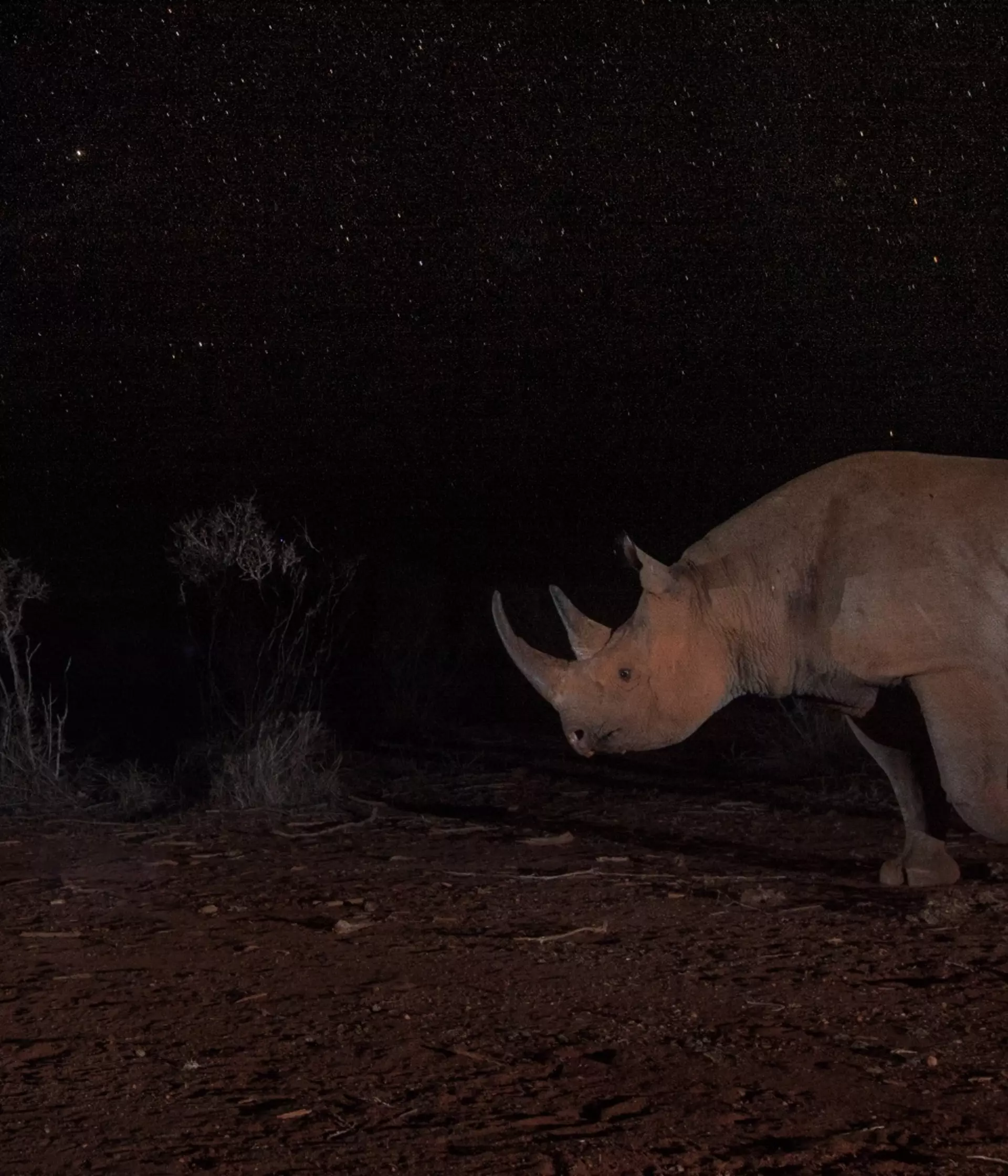Black rhino facts
Black rhinos can’t see very well but they have a keen sense of smell and use this as their primary form of communication. Black rhinos weigh up to 1350kg, that’s over 20 times the average weight of a person! They sustain their massive bodies on a diet of branches, leaves, herbs and succulents – and their constant browsing actually makes them a crucial part of keeping their home landscapes healthy and thriving. Black rhinos are most active at nighttime, and mostly seek shade during the hottest parts of the day.
Black rhino and white rhino differences
Unlike the larger white rhino, they prefer the thick bush to the open savannah. Black rhinos and white rhinos do not have a clear difference in colour, and the main difference between them is their lips, the white rhino has a square upper lip adapted for grazing whereas the black rhino has a hooked upper lip feeding on branches. It's rumoured that White rhinos received their name from a misinterpretation of the Afrikaans word "wyd" describing its mouth, meaning wide.
Black rhino subspecies
There are three remaining sub-species of black rhino: the South-western eastern and Southern central, and Eastern black rhinos. One sub-species from West-central Africa is now extinct. As of 2022, black rhinos could be found in 12 countries in Africa, the largest populations occur in Namibia, South Africa, Kenya and Zimbabwe.
Black rhino population
There are now around 5,550 black rhinos across Africa. In Kenya, between 1970 and 1990, black rhino numbers plummeted from over 20,000 to just 350, due to illegal poaching and habitat loss. That’s why ZSL began working with the Kenya Wildlife Service to conserve and secure the future of this iconic and endangered animal, and many others. Together, we moved many rhinos from high-risk areas into secure sanctuaries, to minimise poaching and maximise the rhinos’ ability to breed successfully. This allowed the population to begin rising slowly, and there are now more than 900 black rhinos in in Kenya.
Black rhino conservation
At ZSL, we find out why species are at risk, and what we can do about it. We deepen our understanding of the natural world through science and use what we learn to bring species back from the brink and restore them into healthy habitats. Much of our work today remains focused on the Tsavo Conservation Area, a vast expanse of wilderness across an area twice the size of Wales.
Historically, Tsavo had the largest black rhino population on the planet; today, it’s where Kenya’s largest numbers of black rhino still roam – as do vitally-important lion, hyena, African wild dog and cheetah populations.
Our collective effort has significantly improved the outlook for this much-loved species, as Moses Wekesa, our Field Manager in Kenya, explains in this video:
Protecting black rhinos
We’re working with lots of different partners to find new ways to fight poaching for the illegal wildlife trade – for example, with technology that uses sensors and cameras to detect humans and wildlife. It provides early warning on the movements of poachers, so that rangers can respond. And it allows conservationists to gather data from remote areas, and monitor wildlife behaviour and changes to their habitats.
We notch the rhinos' ears in a specific pattern in order to effectively monitor the lives of every rhino. These notches can protect the lives of each rhino, through helping our conservationists monitor their movement, health and behaviour. Our conservationists can then easily interpret these notches, to determine the sex, age and history of the individual they have identified whether in the field or through a camera trap.
We’re working hand-in-hand with other local organisations and people to help reduce the burdens of living alongside wildlife and the poverty that can lead to poaching. We’re building positive relationships between local people, park rangers and managers. If together, we can all help rhino to recover, it won’t just be good news for these much-loved and much needed animals, it will support a wider recovery. Black Rhino need large areas of land to survive, so saving these huge herbivores will benefit the many other species that live alongside them.
Sign up to Back from the Brink, and each month we’ll take you to the front line of the conservation work. Including fascinating personal stories, videos and more from our teams saving wildlife around the world and behind-the-scenes in our Zoos.
Helping people live with rhinos
Roughly 5,000 Kamba tribal residents of Mangalete and Kamungi rely heavily on very fragile, limited natural resources either side of the Tsavo national parks. Climate change is increasing the frequency of drought, hurting people and wildlife. Without alternatives, people can resort to wildlife crime, including bushmeat hunting and poaching. We are supporting local organisations are trying to reduce the burden of living alongside a national park.
Establishing a joint team with Tsavo Trust, to implement practical strategies to human-wildlife conflict, such as bee-hive fencing.
Creating foundations for sustainable livelihoods, by working with community chiefs and local partner Five Talents, to establish community-banking groups in Mangalete and Kamungi.
We’re helping create new sustainable career options, by partnering with Wildlife Works to support new small businesses such as soap manufacturing and baobab oil production.
Engaging people in conservation and build relationships with the national parks, we are training community scouts to disrupt and deter wildlife crime.
By working together with communities big and small, we’re helping people live with wildlife. Creating a healthier future for people, wildlife and the planet.
ZSL has been building connections between people and wildlife for 200 years. Today, as human activities push our planet to its limits, that’s more vital than ever – be it working together with people in Mangalete and Kamungi to save animals on the brink of extinction, or bringing people closer to nature through our leading conservation zoos. Why not join us? There are so many ways you can get involved
